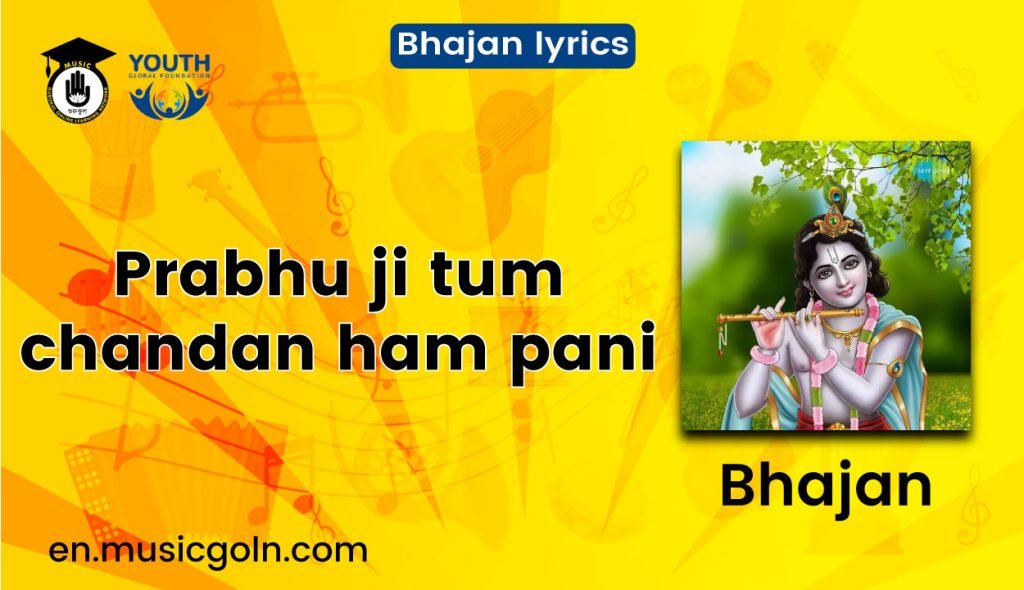Prabhu ji tum chandan ham pani lyrics | Bhajan lyrics
Bhajan refers to any devotional song with a religious theme or spiritual ideas, specifically among Indian religions, in any language.The term bhajanam (Sanskrit) means reverence and originates from the root word bhaj (Sanskrit: भज्), which means to revere, as in ‘Bhaja Govindam’ (Revere Govinda). The term bhajana also means sharing.
The term ‘bhajan’ is also commonly used to refer a group event, with one or more lead singers, accompanied with music, and sometimes dancing. Normally, bhajans are accompanied by percussion instruments such as tabla, dholak or a tambourine. Handheld small cymbals (kartals) are also commonly used to maintain the beat. A bhajan may be sung in a temple, in a home, under a tree in the open, near a river bank or a place of historic significance.
Prabhu ji tum chandan ham pani lyrics | Bhajan lyrics
Prabhu ji tum chandan ham pani lyrics :
Prabhuji, Tum Chandan, Hum Pani
Jaaki Ang Ang Baas Samaani
Prabhuji, Tum Ghan, Ban Hum Mora
Jaise Chitwat Chand Chakora
Prabhuji, Tum Moti, Hum Dhaga
Jaise Sonhe Milat Suhaga
Prabhuji, Tum Deepak Hum Baati,
Jaaki Jyoti Barai Dini Raati
Prabhuji, Tum Swami, Hum Dasa
Aisi Bhakti Karai Raidasa
The Sanskrit word bhajan or bhajana is derived from the root bhaj, which means “divide, share, partake, participate, to belong to”.The word also connotes “attachment, devotion to, fondness for, homage, faith or love, worship, piety to something as a spiritual, religious principle or means of salvation”
In Hinduism, Bhajan and its Bhakti term Kirtan, have roots in the ancient metric and musical traditions of the Vedic era, particularly the Samaveda. The Samaveda Samhita is not meant to be read as a text, but sung as it is like a musical score sheet that must be heard.[10]
Other late Vedic texts mention the two scholars Shilalin (IAST) and Krishashva (IAST), credited to be pioneers in the studies of ancient drama, singing and dance.The art schools of Shilalin and Krishashva may have been associated with the performance of Vedic rituals, which involved story telling with embedded ethical values. The Vedic traditions integrated rituals with performance arts, such as a dramatic play, where not only praises to gods were recited or sung, but the dialogues were part of a dramatic representation and discussion of spiritual themes.
A lyric from a Hindu Bhajan
This body is but a guest of four days,
a house made of dirt.
On this earth your mark is made,
a symbol of your good work.
— Translated by David N. Lorenze
The Vedas and Upanishads celebrate Nada-Brahman, where certain sounds are considered elemental, triggering emotional feelings without necessarily having a literal meaning, and this is deemed a sacred, liminal experience of the primeval ultimate reality and supreme truth. This supreme truth is considered as full of bliss and rasa (emotional taste) in the Hindu thought, and melodic sound is considered a part of human spiritual experience.Devotional music genres such as Bhajan are part of a tradition that emerged from these roots.
Read More :
- Tum Pe Hum Toh Lyrics | Raj Barman | Bole Chudiyan
- Tum Aise Hi Rehna Lyrics | Title song | 2015
- Tum Aa Gaye Ho Noor Aa Gaya Hai Lyrics | Aandhi | Lata Mangeshkar, Kishore Kumar | 1975
- Kar Lo Tum Kadar Hamari Lyrics | Salman Ali | Himesh Reshammiya
- Jab tum aa jate ho samne lyrics | Maharaja | Kavita Krishnamurthy, Sonu Nigam | 1998
- Ankhon men aaya dil men sama lyrics | Dulari | Lata Mangeshkar 1949
